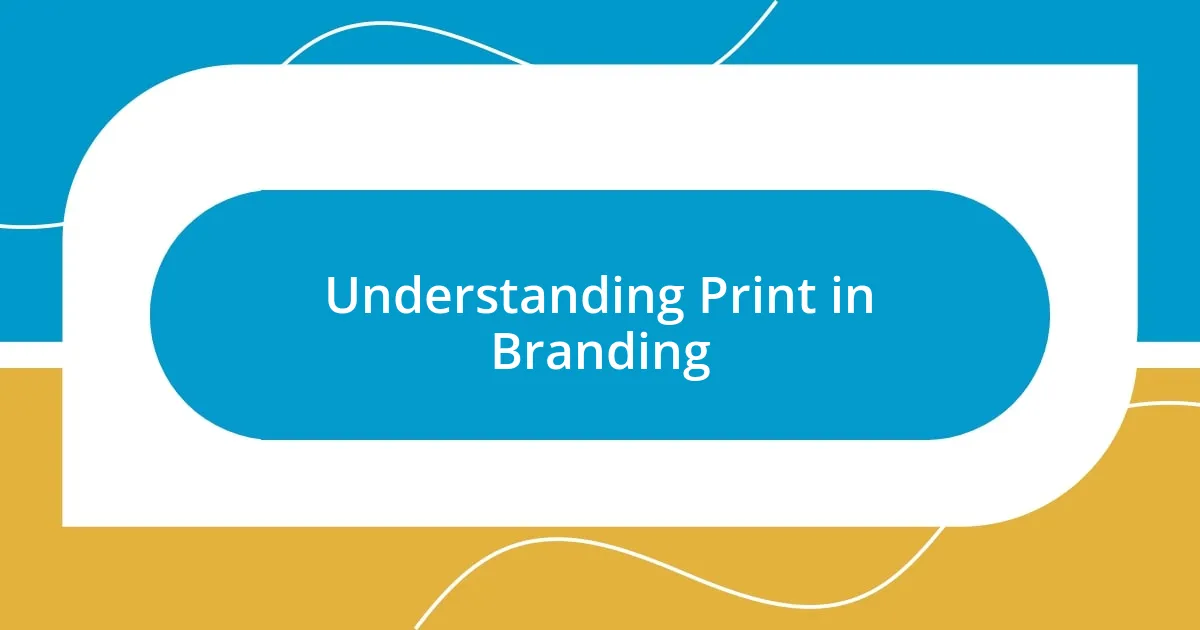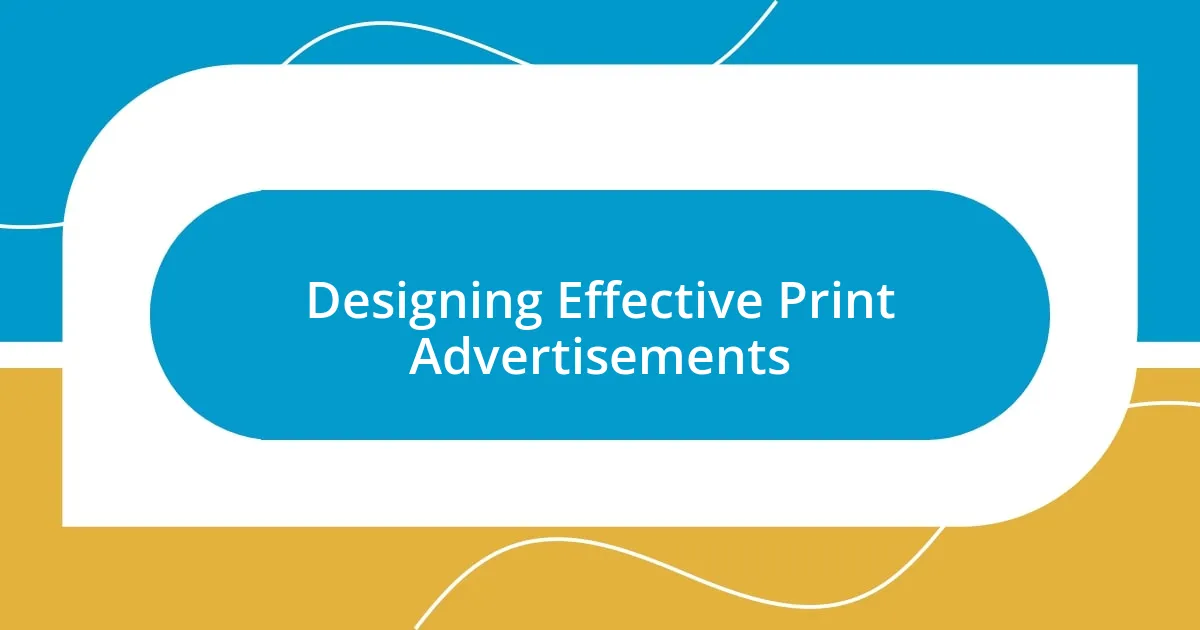Key takeaways:
- Print materials significantly enhance branding by creating tangible connections that are often more memorable than digital content.
- Consistent branding across all materials fosters recognition, trust, and customer loyalty, enhancing a brand’s professionalism.
- Choosing high-quality print materials and thoughtful design elements can emotionally resonate with customers and elevate brand identity.
- Integrating print into marketing campaigns and measuring impact through response rates and feedback can amplify brand messaging and improve engagement.

Understanding Print in Branding
Print is a powerful medium in branding that encompasses everything from business cards to packaging. I remember the first time I handed out my freshly designed business cards; the feel of the textured paper and the vibrant print made an immediate impression. Isn’t it fascinating how a simple card can communicate professionalism and creativity right from the start?
Most people underestimate the impact of print in our digital age. Yet, I’ve found that tangible materials often leave a lasting memory. For instance, when I received a beautifully packaged product adorned with thoughtful design elements, it ignited a sense of excitement. Can you recall a time when packaging influenced your perception of a brand? The visuals, colors, and textures no longer seem secondary; they become integral to the brand experience.
Print allows brands to tell a story and evoke specific emotions, much like a well-crafted narrative. I once collaborated with a local artist to create limited edition prints for a campaign, which not only highlighted our brand’s commitment to creativity but also resonated deeply with our audience. Don’t you think that when brands connect on an emotional level, their message feels more authentic and memorable?

Importance of Consistent Branding
Consistent branding is crucial because it builds recognition and trust among consumers. I’ll never forget when I found a brand I loved; their logo, colors, and style were everywhere. This uniformity made me feel secure, as if I was interacting with a reliable friend each time I encountered their products.
Moreover, I’ve learned that consistent branding can significantly enhance customer loyalty. It creates a unique identity that resonates with the audience. Imagine walking into a store where the product packaging, email communications, and advertising all feel familiar—like an old song you can’t help but sing along to. This familiarity encourages customers to return, which can be fundamental for long-term success.
Finally, it’s remarkable to see how a cohesive branding strategy communicates professionalism. When I revamped my own materials, I ensured that everything—from my letterhead to my website—carried the same design elements. The moment I updated my Instagram to reflect this cohesive visual identity, the engagement from my audience surged. Doesn’t it make sense that when a brand presents itself consistently, it garners more respect and attention?
| Aspect | Impact of Consistent Branding |
|---|---|
| Recognition | Increases brand visibility and trust |
| Loyalty | Builds a strong customer base and repeat purchases |
| Professionalism | Enhances credibility and respect from consumers |

Choosing the Right Print Materials
Choosing the right print materials is pivotal in establishing a brand’s identity and fostering a memorable connection with customers. In my experience, the tactile quality of a brochure or the weight of a business card can influence perceptions more than you would think. I once switched from a standard glossy brochure to a matte finish with a unique texture, and the feedback was overwhelmingly positive. People mentioned how the material made them feel more aligned with my brand’s luxury image, and that taught me the power of touch in print.
When considering print materials, reflect on the practical aspects alongside aesthetic ones. Here are a few key factors I prioritize:
- Material Quality: Higher-quality paper can convey a sense of value and professionalism.
- Finish Options: Different finishes (like matte, glossy, or textured) can evoke various emotions and highlight specific brand attributes.
- Color Accuracy: Ensuring that colors in print match your brand palette is crucial for recognition.
- Sustainability: Eco-friendly materials resonate well with conscious consumers and enhance your brand’s reputation.
- Purpose: Define the goal of each print piece—is it to inform, persuade, or create a memorable experience?
By carefully selecting materials that resonate emotionally with your audience, you create a more meaningful connection, ensuring your brand stands out in a sea of digital noise.

Designing Effective Print Advertisements
Designing effective print advertisements is all about grabbing attention while telling a compelling story. I recall a time when I created a flyer for a local event. Instead of a busy layout filled with text, I opted for striking visual imagery and minimal text. The response was incredible! Attendees said they were drawn in by the vivid colors and bold design, which made the message memorable and enticing. Isn’t it fascinating how sometimes less truly is more?
I also emphasize the importance of choosing a strong call to action, or CTA, when creating print ads. Once, I incorporated a QR code on a postcard that allowed recipients to access a special promotion directly on their phones. The engagement skyrocketed! It’s amazing how a simple, clear directive can enhance the user experience while bridging the gap between print and digital platforms. Why not experiment with different CTAs to see what resonates with your audience?
Finally, I’ve learned that the placement and environment of your print materials heavily influence effectiveness. For instance, I placed a beautifully designed poster in a well-trafficked café, and the impact was immediate. Customers would often stop to take pictures and share them on social media, further promoting my brand. Isn’t it rewarding to see your work take on a life of its own? By thoughtfully considering where and how your print ads appear, you can create a lasting impression far beyond the initial encounter.

Utilizing Print in Marketing Campaigns
Utilizing print in marketing campaigns can really amplify brand messaging and reach. I once launched a community initiative where we distributed branded postcards as invitations. Each card was carefully designed to reflect the event’s theme, and I was amazed by the response! People not only attended, but many also shared their postcards on social media, commenting on how they loved the personal touch. It struck me how print can create a tangible connection that digital invitations often lack.
In my experience, integrating print materials into a cohesive campaign strengthens overall branding. For example, during a seasonal promotion, I used a series of print ads that featured consistent messaging, colors, and imagery across brochures, posters, and door hangers. The result? Customers were more likely to recognize our campaign and, surprisingly, the print pieces often led to an uptick in website visits. It really makes you think—how can you leverage the physical presence of print in your own efforts?
I also recommend thinking about the distribution channels for your print materials. I once collaborated with local businesses to display my flyers alongside their products. The unexpected visibility garnered attention that my standalone efforts hadn’t achieved. This experience taught me the importance of strategic partnerships in print marketing—there’s a magic in exploring the intersection of different brands and audiences. Have you tried partnering with others to amplify your reach? It’s an approach worth considering!

Measuring Print Impact on Branding
Measuring the impact of print on branding can seem challenging, but it’s truly rewarding. I remember attending an event where our promotional brochures were distributed. A few months later, a customer mentioned to me that the brochure was what initially caught their interest. Cue the lightbulb moment! That small piece of print made a lasting impression, demonstrating how effective print can be in not just drawing attention, but also in converting that attention into loyal customers.
One key metric that I often track is the response rate from print campaigns. I once tracked the traffic to my website after mailing out a postcard campaign. The increase in visitors was significant! It made me realize that analyzing response data can provide concrete evidence of print’s effectiveness, turning what seems like just paper into a powerful tool for engagement. Have you considered what print metrics could reveal about your audience?
Another fascinating way I measure print impact is through feedback. When I create a new brochure, I ask viewers directly what they thought. The insights can be invaluable, often highlighting elements I hadn’t considered! Working with a print piece isn’t just about the final output; it’s about allowing it to initiate a conversation with your audience. What better way to shape future designs than by understanding what resonates with them?














